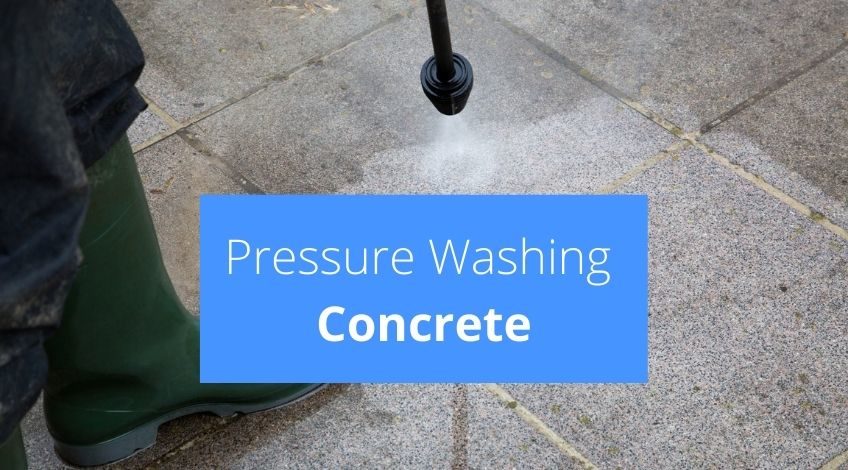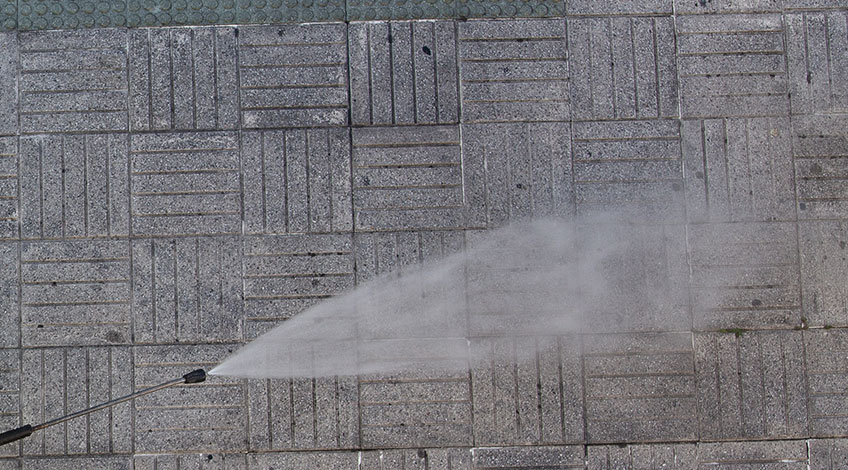
Pressure Washing Concrete? Here’s what you need to know…
Concrete is a porous surface that many people use for driveways, garage floors etc. Many people consider concrete to be a tough surface and in many ways that’s true. However, it is possible to damage concrete just with water pressure.
We often get asked if it’s OK to pressure wash concrete and so we thought we’d put this post together to answer that question once and for all. If you’re considering using a pressure washer on concrete, there are a few safety points to consider first.
Is It Safe To Pressure Wash Concrete?
It is perfectly safe to pressure wash concrete as long as you stick to certain guidelines. Remember pressure washers work by directing water under high-pressure onto dirt and stains to remove those stains quickly and powerfully. That same power can damage the surface material you’re trying to clean.
Safety Guidelines For Pressure Washing Concrete

Here are a few basic safety guidelines before you get started with the pressure washer.
- Always use the correct nozzle
The colour-coded nozzles graduate in power from 0-degrees to 65-degrees, with 0-degrees having the most power. For concrete, the maximum nozzle you should use is the 15-degree (yellow) nozzle. Even this can be too powerful if not used correctly. - Keep the water moving
Never concentrate on one spot, keep the water stream moving at all times to prevent damaging the surface. - Use a cleaner
To ensure that you don’t overdo the pressure by keeping the spray on one spot, use a degreasing cleaner before using the pressure washer. - Use the correct PSi
For concrete, never use more than 3000 Pounds per Square inch of pressure (PSi).
Now we should touch on personal safety because it is so easy to get a serious injury from a pressure washer water spray if you’re not careful.
- Always wear PPE
You should always keep your arms and legs covered by wearing long-sleeved shirts and long trousers. Protect your eyes with goggles, wear boots or closed in shoes, protect the hands with gloves and consider ear protectors if your pressure washer is particularly loud. - Remove any trip hazards
Be sure to move any plant pots, tools, toys, cables, pipes, garden furniture and any other items from the area you are going to clean. - Protect electrics
Any outdoor electrical equipment like junction boxes, meters, power points, or any other electrical items should be covered with plastic sheeting to prevent any water damage. - Protect doors and windows
If the area you plan on pressure washing is near any doors or windows it’s best to cover these with plastic sheeting held in place with masking tape to prevent any damage from water spray or flying debris. - Look after plants
Any plants growing in the ground nearby should also be covered to protect them from spray, detergents or debris. - Look after the kids
Whenever you’re out in the garden, the kids like to be with you, and that’s great except when using a pressure washer. Too many young children have been hospitalised due to pressure washer injuries, don’t let it happen to yours. - Keep pets safe
It’s not just the kids, think about the pets too.
Pressure Washing Concrete – A Step By Step Guide
Here’s the correct way to safely pressure wash concrete in 8 easy to follow steps.
- Sweep the area
Use a stiff yard broom to remove as much dirt and debris as possible from the area you intend to clean. - Apply a degreaser
If the area has any dried-on oil or grease stains apply a degreaser and leave for the recommended time to soak in. - Turn the water on
Connect the garden hose to the pressure washer and turn the tap fully on. Pull the trigger to allow water to pass through the pressure washer for 30 seconds or so to remove any air. Then turn on the pressure washer. - Fill detergent container
Use only a concrete detergent approved by your pressure washer manufacturer. - Wet the surface
Be sure the whole area is completely covered with water. Using the white nozzle. - Wash the concrete
Change to the black (detergent) nozzle and apply the detergent to the whole area, allow the detergent to work into the surface for 10 to 15 minutes. - Rinse the concrete
Change to the white nozzle, and starting at one end rinse the whole area. Remember to keep the wand moving at all times and never concentrate on one area for too long. If you need more power to remove stains, change to the green nozzle and rinse again. - Allow to dry
Once the concrete is completely dry you can seal using a specialised concrete sealant.
Frequently Asked Questions
You can damage concrete by power washing if you use too much power or concentrate the spray on one area for too long.
You should put a degreaser on concrete before pressure washing to remove any ground-in stains.
You should seal the concrete after power washing to protect the surface from dirt, grease and damage.
After pressure washing, you should allow at least 24 hours for the concrete to dry out before you seal it.
You can usually walk on the concrete after about 24 hours after it has been sealed.
To seal concrete the temperature needs to be between 50 to 90 degrees F (10 to 32 C) Temperatures too hot or too cold will affect the drying time and its effectiveness as well.
Also, follow us on Pinterest ...



